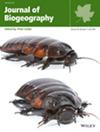Solar Radiation and Temperature as Key Predictors of Taxonomic, Phylogenetic and Functional Beta Diversity in Sigmodontine Rodents
Abstract
Aim
Beta diversity is essential for understanding how biological communities change along environmental gradients. Here we examined the taxonomic, phylogenetic and functional beta diversity patterns of sigmodontine rodents. We tested the influence of geographic distance and three environmental hypotheses: (1) water availability and productivity, (2) energy availability and (3) climatic stability, interpreting them through the lens of beta diversity and its components.
Location
Northwestern Argentina (NWA).
Taxon
Sigmodontinae (Rodentia, Cricetidae).
Methods
We compiled a comprehensive museum-based specimen database complemented with bibliographic records and field-based surveys, resulting in 44 species of sigmodontines from 330 localities in NWA. For each pair of sites, we calculated beta diversity and partitioned it into turnover (substitution of species) and nestedness (difference in species richness). Then, we used multiple regression on distance matrices to test the influence of geographical and environmental variables on total beta diversity and its components on the taxonomic, phylogenetic and functional dimensions.
Results
We found that turnover contributed more to total beta diversity than nestedness for all dimensions but to a larger degree for taxonomic than phylogenetic and functional dimensions. Elevation was the predictor with the highest explanatory value for total taxonomic beta diversity with an inverse relationship. Solar radiation and the minimum temperature of the coldest month emerged as the main predictors for total phylogenetic and functional beta diversity, respectively, also with an inverse relationship. Among the environmental hypotheses, energy availability had the highest explanatory power. When mapping the variation of beta diversity for the three measured dimensions, we found an abrupt shift between the eastern lowlands and the western highlands, coincident with the South American Transition Zone, where the Andean and Neotropical biogeographic regions meet.
Main Conclusions
These findings highlight the importance of thermal and solar radiation gradients as key drivers of beta diversity in sigmodontine rodents. Our study provides novel insights into the environmental drivers shaping rodent beta diversity on three different dimensions (taxonomic, phylogenetic and functional) in complex landscapes, emphasising the importance of examining multiple dimensions in biodiversity studies.

 求助内容:
求助内容: 应助结果提醒方式:
应助结果提醒方式:


